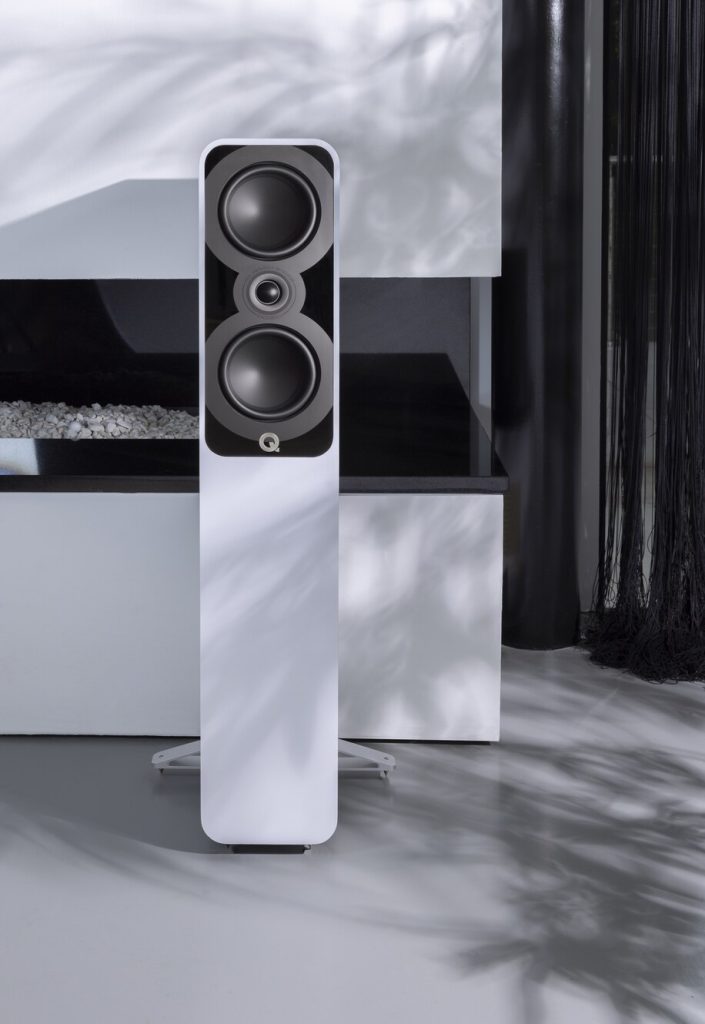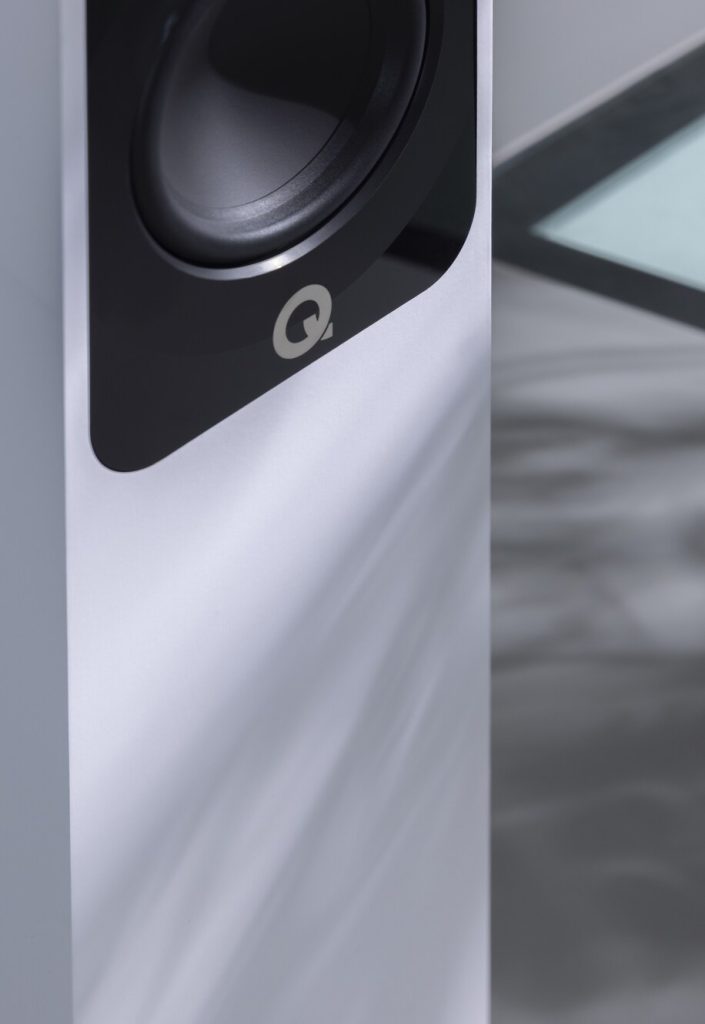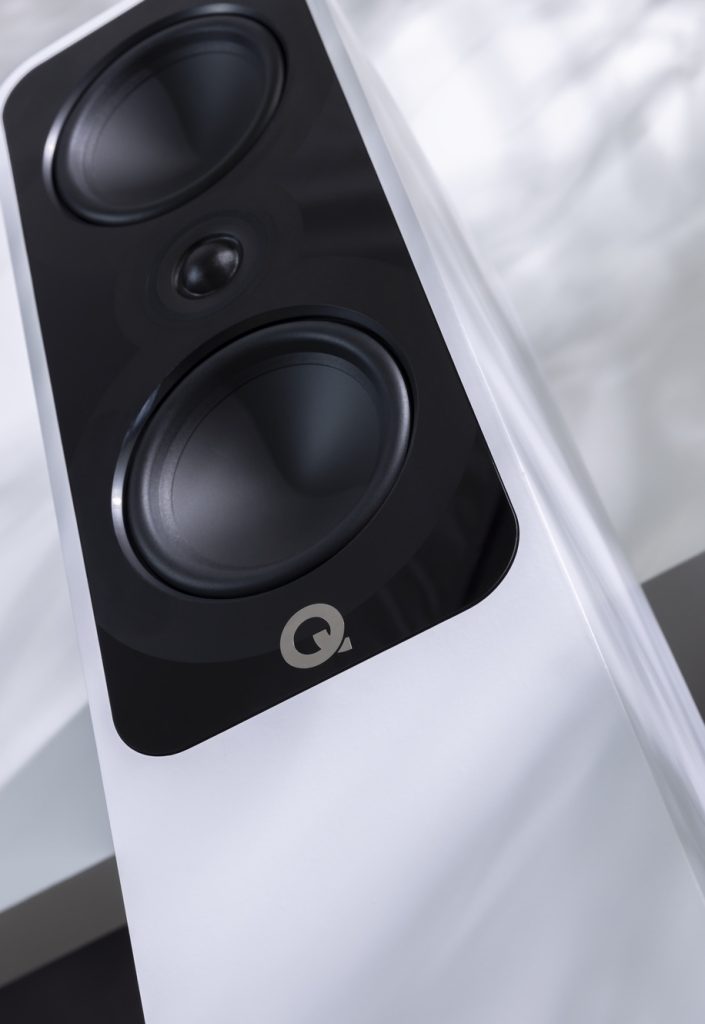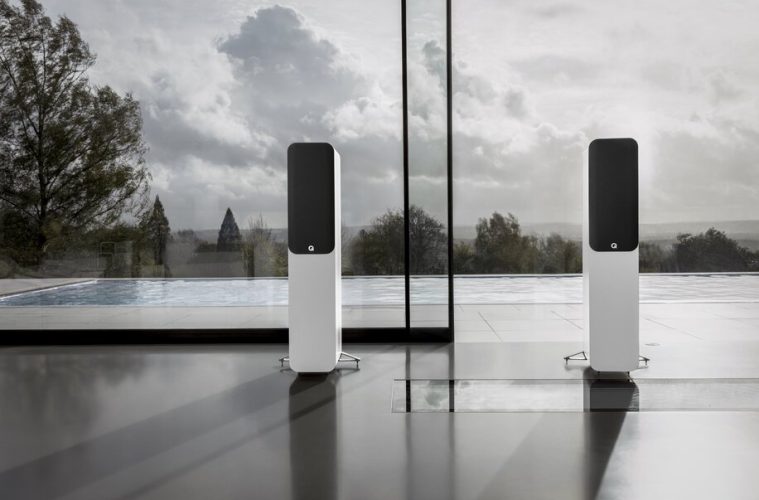Our intrepid trade-focused reviewer, Richard Stevenson, takes a listen to the recently released Q Acoustics 5040. A competitively priced (£999 retail) pair that promises to pack a punch.
Q Acoustics’ loudspeaker range offers a lot to like at both the entry-level 3000i Series and the far more affluent Concept 30/50/90 family. In between the two there existed a Polo-like void. Enter the Q Acoustics 5000 series, aiming to bring much of the performance of the premium models through trickle-down technology, with the sort of great value that has made the 3000i Series best sellers.
The 5040 is the smaller of two floorstanders in the range. Compact and slimline, it packs a pair of 5in mid/bass drivers and a 1in dome tweeter ‘floating’ (isolated) in the baffle. The cabinet is sleek and contemporary, with all of Q-Acoustics’ signature design cues present and correct. Solid build, tick. Curved horizontal edges, tick. Rear outrigger feet, tick.
Despite casting a similar shadow to the Concept 50, it is easy to see where some cost savings have been made in terms of reduced design flourishes. The 5040 is simpler looking, less fussy, and, for those with an eye for purist contemporary design, arguably even better looking than its pricier cousin. Our satin white review pair looked particularly lush in the room, and the vinyl wrap and finish are absolutely faultless throughout.

Trickle Down
Top of the trickle-down tech list is Q-Acoustics’ C3 Continuous Curved Cone diaphragm on the two mid/bass drivers. The design is said to combine the bass performance of a traditional straight-sided cone with the improved mid-range frequency control of a flared shape. Given that the 5040 packs a bass punch like Tyson Fury while remaining exceptionally well controlled, I’d go with certain success there.
The MDF cabinet deploys Q-Acoustics’ P2P (Point to Point) bracing to give the enclosure maximum support through audio band vibrations, and a no-frills crossover; albeit using some rather tasty components. The cabinet is rear ported with a foam bung supplied for some LF attenuation if placed close to a back wall and is supplied with a magnetic-fit plastic grill.
The three drivers are arranged in D’Appolito configuration with identical min/bass above and below the tweeter. This creates a dispersion pattern that is wider than it is tall, reducing sound output that would otherwise bounce off the ceiling and floor, potentially muddying the direct sound from the speaker.
Speaker set-up is no more arduous than four Allen-head bolts to secure the rear aluminium outriggers and four M4 spikes with locknuts as feet per speaker. The speaker terminals are perhaps the only part of the design that I find a little challenging. The flat binding posts with 4mm banana sockets are a sleek work of art to behold and offer very little protrusion out of the back of the cabinet. Yet, for my saveloy-like fingers, the shallow profile and inset positioning make it a real faff to tighten up on spades or bare wires.
On the plus side, once secured, the low profile means the speaker can be parked much closer to a rear wall than most designs with traditional chunky speaker terminals. Having tried both freestanding and close-to-wall placement, the freestanding is better for imaging and articulation, but being close to the wall, with the port bung fitted, doesn’t upset the 5040’s overall performance.

Inside info
Electronically, this is a modern speaker with a 6-ohm nominal load that will not upset all but the flakiest of amplifiers and offers 91dB/w efficiency. Now, that is quite a claim for a compact floorstander packing no more than the ‘two-fives’, and perhaps 88 or 89dB/W would be more the norm for these dimensions. Given that 3dB represents a doubling in sound pressure (or about +30% in perceived volume), the 5040 looks like it can party with the best of them.
A quick Google search will reveal that the 5040 already scooped innumerable consumer magazine accolades before arriving at EI, and I can certainly see why. From the first bars, these compact floorstanders sound a lot bigger than they are, delivering an engaging, foot-tapping presentation underpinned by bass that punches a lot harder than those two-fives have any right to.
The balance has gained some serious energy over the 3000i models I have listened to previously, and I wouldn’t be surprised to find a slightly ‘smiley face’ EQ curve if measured. The tweeter is fast and very detailed and sits slightly forward in the overall mix. Combined with the rich and weighty bass, which alone has made me a huge fan of these speakers, the presentation has masses of get-up-and-go!
A quick blast of Faithless We Come 1 sees the 5040s establish themselves as happy dance party accessories while switching straight to Anette Askvik’s Hi-Fi-show standard Liberty demonstrates they cut it equally well with smooth vocals and moody atmosphere. Cody Fry’s symphonic interpretation of Eleanor Rigby would stretch any speaker’s resolve from its emotional lyrics to detailed instruments, and the huge orchestral crescendos. The 5040 handles it all with remarkable grace and aplomb, making for a very musical, very enjoyable experience.
That 91dB/W sensitivity really pays dividends with those big orchestral pieces and rock/pop music, too, meaning these bad boys can go loud without the need for kilowatt-sized amplification.

Verdict
At under £1000 retail, the 5040 is a first-class bargain for consumers or installers looking to add some true Hi-Fi performance to their audio installations. It is sleek, beautifully made, outstandingly musical with any genre, happy to party, and, thanks to the flush terminals and port bung, has flexible room portioning options. Even the quirky terminals are actually very clever and only a little faffy on the initial installation.
While affordable stereo speaker pairs may not be the mainstay of the CI industry, even for customers specifying six-figure cinemas or whole home AV installations, there will be room somewhere that the 5040s can bring a little bit of extra magic to the overall package.


